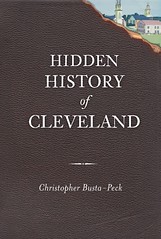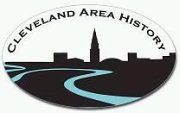
I recently obtained ten 4x5 glass plate negatives of Cleveland scenes, taken in 1927. Thanks to the assistance of Bill Barrow, Special Collections Librarian at Cleveland State University and the Digital Production Unit there I was able to get the negatives digitized at 1200 dpi. This provides a very high resolution look at these parts of Cleveland.
In the first post in this series, I shared a few scenes that were reasonably familiar - the Terminal Tower, the Arcade, and Public Auditorium. This photo is the last one that will contain many obviously recognizable buildings.
The scene shown here is of the intersection of Carnegie Avenue (then Central Avenue) and East 14th Street. The camera is pointed to the northwest.
To the left is St. Anthony of Padua Roman Catholic Church, still standing. Next to it, the May Company garage. Behind them, one can see a bit of green space - Erie Street Cemetery. Behind this row of buildings sits Brownwell Junior High School, also still standing. On the same block, we can also see H.F. Wolff's garage. In the foreground, there is a Rex gas station.
On another corner, there is a tailor, print shop, and restaurant. On East 14th Street, on the far left, is a building that for some reason continues to catch my eye, perhaps because of elements that seem almost Art Nouveau.

This photo shows the view west on Carnegie Avenue from East 14th Street. The sign of H.F. Wolff Garage can be seen on the right. We can also see the spires of St. Anthony of Padua. Other than that, just about all of the buildings shown here - both houses and commercial establishments - are now gone.
There are so many questions. What is the building in the distance, in the center, that looks like a church? And what enterprise was served by the distant water tower?
These photographs help to serve as a historical record of this bit of lost Cleveland. In the next group of photographs, I'll explore more of this now-lost section of Carnegie Avenue.




the camera is pointed to the northwest in the first photo, not northeast.
ReplyDeleteOops. Thank you for catching that typo on my part.
ReplyDeleteThe distant water tower says ___onora ___offee
ReplyDeleteMust have been some kind of coffee factory.
That's St. Maron's Lebanese catholic church on the right, which is still standing. It's the church right next to what is now the Middle East Bakery. My grandparents were instrumental in that church being built in and around 1915. Thanks for the photos!
ReplyDeleteIf these photos are from 1927, isn't it odd that there is a billboard for Budweiser, considering Prohibition spanned from 1920-1933?
ReplyDeleteBudweiser did continue to sell (non-alcoholic) products during prohibition - yeast for one.
ReplyDeleteI based the date on items that definitively gave the year in other photographs in the series, which were all clearly taken by the same camera. However, there are other things in this photo that can allow us to be reasonably sure that it was taken at the same time as the other photos.
The Ohio Bell Building can be seen behind the Caxton Building, which, in turn, is behind Brownwell Junior High School. The Ohio Bell Building was constructed from 1925 to 1927. The level of progress in the construction implies a date of 1926 or later.
Further, while there are some cars that were clearly built in the 1920s, there are plenty of earlier ones as well. In a photo taken in the late 1930s, there would be fewer cars from the 1910s.
There used to be a "Sonora Coffee"...
ReplyDeleteThe water tower is on top of the old Haserot Building at 521 Woodland. Among others, their Senora brand of coffee was roasted, packaged, and distributed from there for decades. Today, the D gate at Jacobs Field stands roughly in this spot, and Northern Haserot continues to distribute wholesale foods from their facility in Bedford.
ReplyDelete